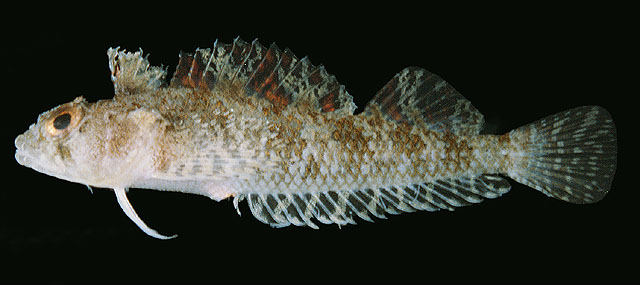| Tripterygiidae (Triplefin blennies), subfamily: Tripterygiinae |
| 7.3 cm TL (male/unsexed) |
|
reef-associated; marine; depth range 1 - 25 m |
| Indo-West Pacific: widespread; from the Red Sea to South Africa; from Sri Lanka, the east and west coast of Australia, Indonesia, southern Japan and east to the Marshall Islands, New Caledonia and Fiji. |
|
Dorsal spines (total): 18-19; Dorsal soft rays (total): 10-11; Anal spines: 2-2; Anal soft rays: 20-21. This species is distinguished by the following characters: D IV + XIV-XV + 10-11 (IV+XV+11); A II, 20-21 (21), spine length half of the rays; pectoral rays 16, dorsalmost 2-3 and ventral most 7 simple, remainder branched once; pelvic rays bound together by membrane for less than one-fourth of length of shorter ray; lateral line pored scales 21-24 (22), terminates between 2nd and 3rd dorsal fins; notched scales and 14-19 (16); total lateral scales 32-35 (34); dentary pores 5-6 + 1 + 5-6; orbital and nasal cirri palmate and about as large as pupil diameter; dorsal fin also with cirri at tips of spines; head 2.9-3.6 (3.3) in SL, eye 3.0-3.9 (3.3), maxilla 2.3-3.0 (2.6) and snout 3.3-4.9 (3.8) in head length (Ref. 88983).
Description: Heavily pigmented (Ref. 1602). Overall greyish or brownish with 5 white saddles on dorsal side extending to fins, eye bar black and broad, anal fin vertical bands black, caudal fin bands grey and white (Ref. 90102). |
| Adults inhabit coral or rock, often under ledges, on clear lagoon and seaward reefs (Ref. 13227). Eggs are hemispherical and covered with numerous sticky threads that anchor them in the algae on the nesting sites (Ref. 240). Larvae are planktonic which occur primarily in shallow, nearshore waters (Ref. 94114). |
|
Least Concern (LC); Date assessed: 07 May 2010 Ref. (130435)
|
| harmless |
|
Source and more info: www.fishbase.org. For personal, classroom, and other internal use only. Not for publication.

